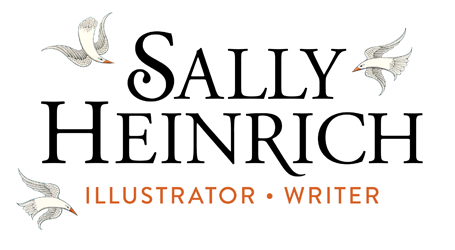South Australians are often surprised to discover the range of local people who have contributed to many areas of society at a local, national and international level. These images are from an exhibition of hand coloured lino prints containing a personal and idiosyncratic selection of some of these people. All images are 24 x 29 cm, printed on paper approx 32 x 39 cm. Black and White versions also available. Please contact me to ask about availability if you’re interested in purchasing any of the prints. Some of the images have also been used for tea towels and tote bags – check my online store.
I plan to continue to add to this series, so if you have any suggestions of who you consider to be a Local Icon, please let me know!
Artwork for this exhibition was created with the assistance of Arts SA, for which I’m very grateful.
So, in no particular order, here we go …
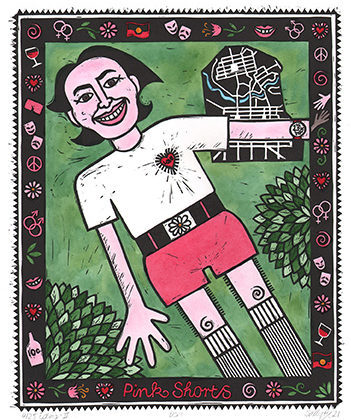
Don
Don Dunstan’s socially progressive leadership of SA during the 60s and 70s oversaw (amongst other things) the recognition of Aboriginal land rights, the decriminalisation of homosexuality, the abolishment of the death penalty, the relaxation of censorship and drinking laws. On top of all that, he was a great supporter of the arts.
One day when I was very young, my parents and I were passing through Murray Bridge, where my Dad grew up. There was a huge crowd in the park near the river, and on investigation we discovered they were crowded around a raised stage, gazing adoringly at the Premier, Don Dunstan. Ceremonially he cut a ribbon, placed a 20-cent coin in the slot of a small metal box and, for the first time, Bert the Bunyip emerged roaring from the water. I remember Don was resplendent in a short-sleeved and short-legged safari suit and I’m quite sure that it was pink. Like the very short pink shorts he turned up to Parliament in, one hot November day.
This print is based on an iconic newspaper photograph taken that day, as well as Barbara Hanrahan’s (another Local Icon) screenprint Flying Mother.
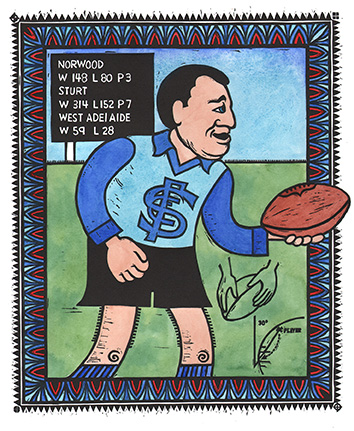
Jack
Two of my earliest memories of me and my Dad –
1. Walking down the stairs into the Adelaide Typographers, to the clatter of Linotype machines and printing presses, and the smell of ink.
2. Running down the hill at Unley Oval, returning to stand by my Dad’s legs amidst a sea of legs, feeling the energy of the crowd as a tangible thing,
periodically erupting in a synchronised cheer or groan.
So what has this to do with Jack? You may have picked the Unley connection. He was the coach of Dad’s (and thus my) team Sturt, but he was also Dad’s boss, Dad being his second-in-command. Jack was a Linotype operator, my Dad a compositor. According to an ex-colleague, Jack, Dad and their team were the best people he’d worked with in a 52-year career.
As a coach, Jack excelled. He holds the record for coaching more elite level victories than any other, a total of 521, and the most Premierships as coach 10 (equal top) including five in a row.
He is also credited with revolutionising the game by instigating the greater use of handball as an attacking option and popularising the check side punt, which has itself been listed as a South Australian icon. He was inducted into the Australian Football Hall of Fame in 1996 and was elevated to legend status in 2021, only the second Legend to have played and coached his entire career in South Australia.
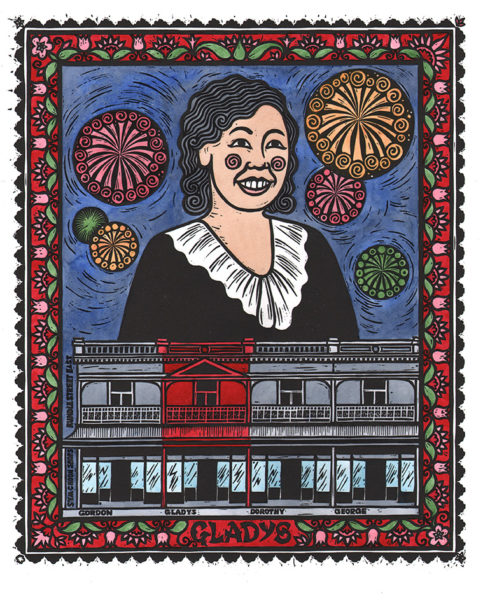
Gladys
Miss Gladys Sym Choon’s is well known since the 80s amongst Adelaide’s most trendy and style-conscious. Not that I consider myself one of them, but I have bought a number of outfits from there over the years, including a memorable and much loved pair of pointy black stiletto boots.
Prior to that, however, I remember visiting the store in its previous incarnation as the China Gift Store, where I found all sorts of wondrous and exotic items such as delicate Chinese papercuts.
Gladys was the first woman in SA to run a business in her own right at only 16. She travelled regularly to China to buy her stock, which included embroidered silks and lingerie, carved ebony and eggshell china, cloisonné and exquisitely hand-worked table linen. Her father bought four shops in Rundle Street East, one for each of his children. Dorothy leased hers, but George and Gordon ran similar businesses selling all sorts of things including matches and chewing gum, homemade pickles, nuts and ice cream. In the lead up to Guy Fawkes the people of Adelaide would queue to buy fireworks.
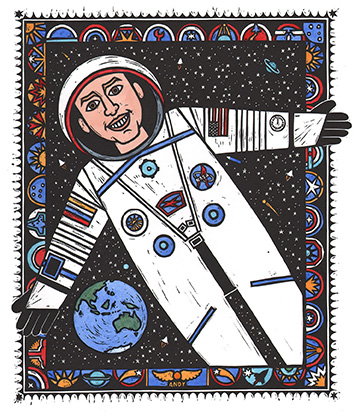
Andy
Andy Thomas, born and bred in Adelaide, was the first, and so far only, Australian-born astronaut to go into space. (Okay, so there was another Aussie, Paul Scully-Power, who went to space earlier, but as a civilian oceanographer, not an astronaut.) In all he had four space flights, represented by four rockets in the print, including a space walk – how cool is that?
When asked about his experiences in space, he said that on his first trip he kept losing pens and pencils. They floated off and hid behind things …
The images in the border are based on Andy’s mission badges.
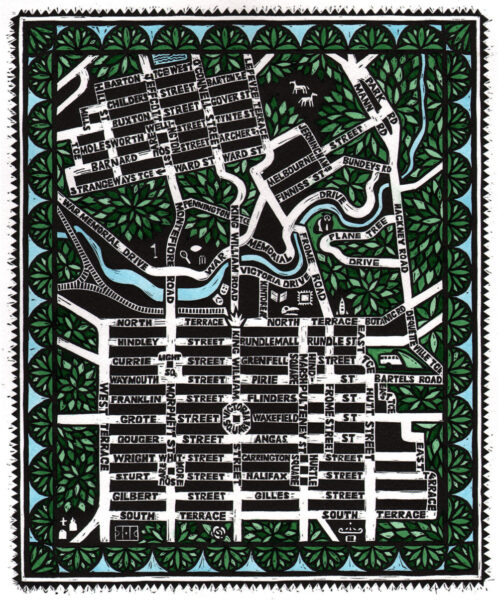
City Streets
The street names for the City of Adelaide were gazetted on 3 June 1837. A Street Naming Committee was made up of the Governor and eleven prominent citizens.
King William Street, running north-south and bisecting the city, is named after King William IV. Between North Terrace and South Terrace, all east-west roads change their names as they cross King William Street, a source of much confusion amongst even long-term residents. Some say that this is because no-one is allowed to cross the path of a monarch. This may be true, but it also enabled more names to be assigned. Some of the north-south streets as well as some streets in North Adelaide also have separately named sections.
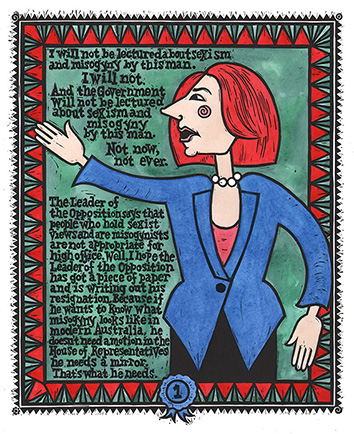
Julia
Yes, I know she was born in Wales, but she’s ours, isn’t she? Our first female Prime Minister and our first red-haired PM. I think it’s ok to say that, because she allegedly called herself ‘ranga-in-chief’ (Is this true? I tried to check but could find nothing to disprove it.) I relate. I might not be a natural redhead but I’ve been one for so long I can’t actually remember what colour my hair really is. Julia’s time as PM was a somewhat fraught tenure, but there’s some things that can’t be taken away, including the magnificence of her legendary misogyny speech.
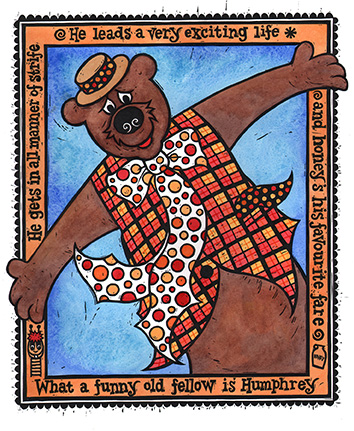
Humphrey
Before I started school, one of my daily afternoon rituals was watching the Channel Niners. The main attraction of the show was, of course, Humphrey B. Bear.
Another highlight was the weekly drawing competition. There was always a theme – Freddo Frog playing football, Freddo Frog at the beach, Freddo Frog eating ice cream and so on. (Clearly Cadbury was a big sponsor.) As soon as the week’s theme was announced I’d get to work, draw my entry and give it to Mum to post. Once I won a consolation prize. We had to go to the Channel 9 studios to collect it, a box containing five of every flavour of Freddo.
Not satisfied, I kept going and eventually (was it simply my persistence?) won first prize. Now, this was really exciting as I had to actually appear on the show. On live TV! I sat in the studio audience with my sister, waiting for my brief, nerve-wracking appearance on screen. My ‘thank-you’ was so shy and quiet that Mum and Dad watching at home couldn’t hear it. The highlight of the night, however, came as the studio audience filed out at the end of the show. We were farewelled by Humphrey and, oh my goodness, I was allowed to kiss him on the nose.
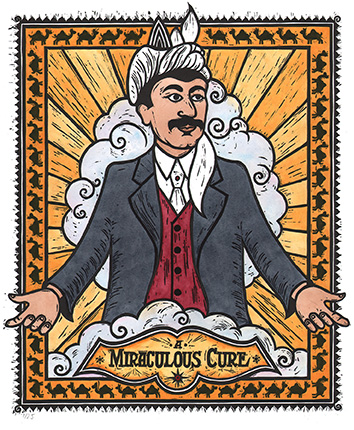
Mahomet Allum
Why had I not heard of this man until recently? Known as a herbalist and healer, some called him a charlatan and the medical establishment despised him, yet he was loved enough by his clients and the public generally, that when he announced he was returning to Afghanistan in 1953, a petition gathered 19,000 (no that’s not a typo) signatures begging him to return as soon as possible.
Born in Kandahar, in his youth he travelled through Asia selling Arab horses and camels to the British army. He first came to Australia in 1899 as a camel driver, working everywhere from Kalgoorlie to Broome, Townsville to Bourke. He also worked as a draper and a miner (to learn about miners’ ailments) and distributed his herbal medicines to those in need as he travelled around. Once he established his business in Sturt Street ,he became a well-known figure and saw hundreds of patients a day on a donations-only basis, and donated most of his income to the needy. He was known as ‘…a generous philanthropist, devout Muslim and stylish dresser.’ He was referred to as ‘Humanity’s benefactor’, ‘Wonder Man’ and Adelaide’s ‘Uncrowned King’.
In his 80s he married Jean, a 19-year-old patient, with whom he had a daughter. Mahomet Allum died in 1964 at 106, or possibly 108. His funeral procession from the Adelaide Mosque stretched for over 1.6 km. He left nearly all his estate to charities that cared for children and bought fourteen plots at Centennial Park for other Muslims who couldn’t afford a proper burial.
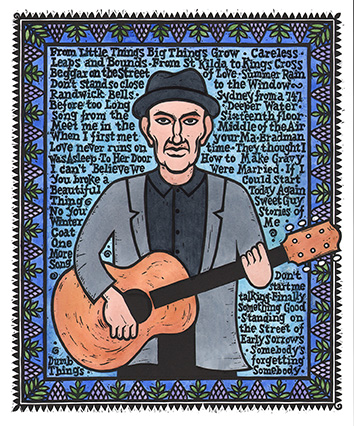
Paul
Could he be Australia’s Poet Laureate? Paul has provided the soundtrack to much of my life. I’ve seen him play more times than I can count. One night that stands out was at the Tivoli in the mid-80s (well, where did you go on a Saturday night?), enveloped in cigarette smoke, feet sticking to the carpet (probably in my back stiletto boots …) crushed shoulder to shoulder, ears ringing as the home-town crowd roared their approval of Adelaide sharing, or possibly totally missing, the irony.
The song titles in the print were chosen by asking friends their fave PK songs. There was a lot of common ground but a few outliers. Overall winner? Tough call … Gravy perhaps (though it’s not in my personal top ten), possibly Dumb Things by a whisker.
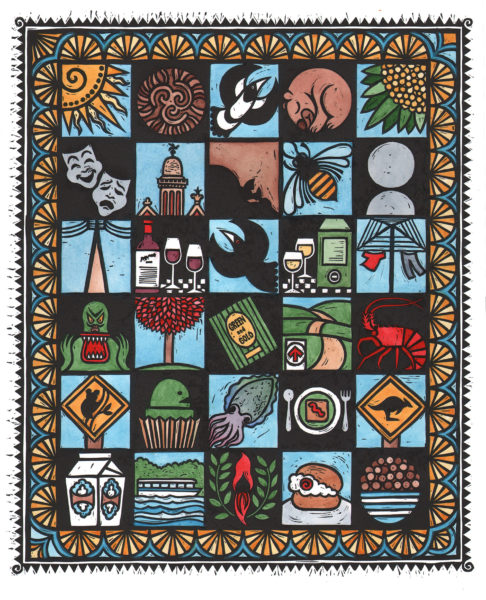
Local Icons
A collection of some of the non-human South Australian Icons. Left to right, top to bottom – Sunshine, Ediacaran fossil, Piping Shrike, Hairy-nosed Wombat, Golden Wattle, the Arts, Beehive Corner, SA, Ligurian Bee, ‘Mall’s Balls’, Stobie Pole, Penfolds Grange, Crow, Wine Cask, Hills Hoist, Bert the Bunyip, Claret Ash, Green and Gold Cookbook, the Heysen Trail, the Big Lobster, Koalas, Frog Cakes, Giant Cuttlefish, Pie Floater, Kangaroos, Farmers Union Iced Coffee, Popeye, Sturts Desert Pea,
Kitchener Bun, FruChocs.
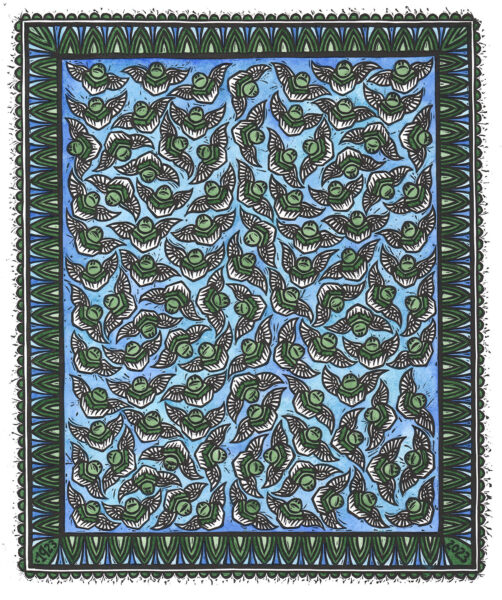
100 Years of Frog Cakes
Anyone who grew up in Adelaide will have eaten at least one frog cake in their lives.
For the uninitiated, a frog cake consists of a sponge cake base, with a jam centre, topped with artificial cream, covered with a layer of fondant icing. The open mouth is formed with a hot knife and eyes added in contrasting fondant.
They were introduced into the Balfours’ range in the 1920s, possibly after one of the family members returned from Paris, inspired by fondant covered petit fours he saw there. Tea rooms were popular at that time, and it was one of the ‘assorted fancies’ introduced, but soon became a mascot for the company. Originally exclusively green, later chocolate and pink versions were added to the range. The recipe remains identical to this day. A century later, there’s no denying they are an SA icon.

Bob
How could I fail to include our most popular PM of all time? Born in Bordertown. 75% approval rating? Incredible. I wonder how much of that is due to his Guinness world record for drinking a yard of beer in eleven seconds (it’s since been more than halved – please don’t try this at home) although he didn’t touch a drop whilst in power. Doesn’t really matter. He was a good leader as well as a good bloke. He lost me for a while over the Hazel/Blanche thing, but I came round again. He’s only the second politician I’ve shed a tear over when they died – and I’m not a cryer. (Who else? Gough. Of course.) Bob was known to shed a tear on occasion as well.
The icons in the border reference the ways his government changed Australia – floating the Australian Dollar, opening the Australian economy to global competition, launching Medicare, striking the Prices and Incomes Accord with unions, giving the Commonwealth power over World Heritage sites, saving the Franklin, banning uranium mining at Jabiluka, outlawing gender discrimination in the workplace, proclaiming Advance Australia Fair as the national anthem and green and gold as the national colours – as well as his leadership of the ACTU, his Rhodes scholarship and the America’s Cup victory which prompted one of his most well-known quotes, ‘Any boss who sacks anyone for not turning up today is a bum.’
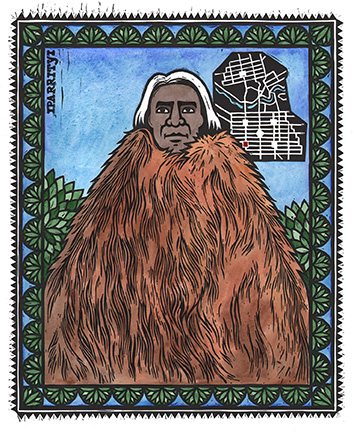
Iparrityi
Since becoming a city dweller a few years ago, I have spent a lot of time walking in and around the parklands, and getting to know something of their personalities and histories. Of the thirty-two named parks and six named squares, nine are named after women. Seven of those nine are Aboriginal women.
Iparrityi, in the southwest corner of the city square mile is also known as
Whitmore Square. It is named to honour the ‘last woman of the Adelaide tribe’, who is also often acknowledged as the last full Kaurna speaker. Iparrityi, whose name translates as ‘gentle, misty rain’, was born in the 1840s at Port Adelaide and died in 1929. Hurtle Square in the Southeast corner is named for her Mother, Tangkairi.
Iparrityi was also known as Amelia Taylor and Amelia Savage from her two marriages, Princess Amelia and Turku Nganki, ‘mother to many’. She was known for her keen intelligence and sense of humour. The knowledge she passed on about the Kaurna people, language, customs and important sites throughout Adelaide has been invaluable to understanding and preserving them for future generations.
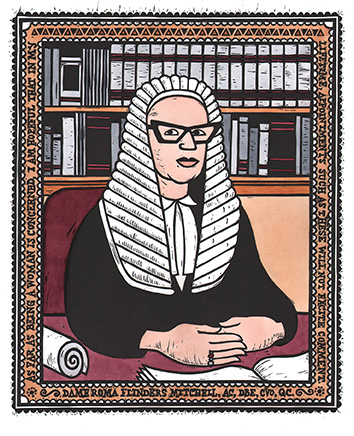
Roma
Dame Roma Mitchell, born in Adelaide in 1913, was a woman of many firsts. First female judge in Australia (at the recommendation of Don Dunstan), first woman to be a Queen’s Counsel, first female Chancellor of an Australian University, and first female Governor of an Australian State (31st Governor of South Australia from 6 February 1991 to 21 July 1996).
At her funeral, the then Governor General Sir William Deane said that she had ‘… blazed a trail for all Australian women, in law, in government, in academic life, in public and philanthropic service.’
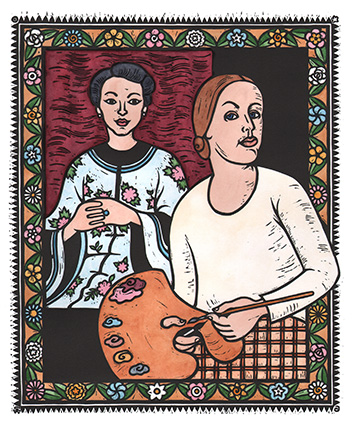
Nora
Often overlooked because of her famous father, Nora was born in 1911, the fourth of eight children, and grew up at the Cedars, near Hahndorf.
Nora battled criticism from men throughout her career. Despite this, her talent was obvious from an early age, and by the time she was twenty she had work hanging in three state galleries. She and her father had a verbal agreement not to trespass, too much, into each other’s territories. She would leave the landscapes to him, and stick to portraiture and still life.
She was the first woman to win the Archibald Prize for portraiture. Always a contentious prize, her win was widely criticised. Max Meldrum, a well-known artist and art teacher of the time remarked that ‘… to expect them (women) to do some things equally as well as men is sheer lunacy …’.
She was the first Australian woman to be appointed as an official war artist. Coming from a family that weren’t supportive of the war, she brought an unconventional and original perspective to the role.
After her early success, she was mostly overlooked by the Australian art community, partly because of trends in painting away from the figurative towards abstraction, but also because she wasn’t a self-promoter and never sought celebrity. She was impatient with press reports that focused on her gender and family background. She simply wanted to paint what she wanted to. Recently in a gallery in Hobart, I saw salon hang of a collection of portraits, one of Nora’s amongst them, and was struck by just how contemporary it was and how it stood out, especially compared to other work from the same period.
This print references both her 1938 Archibald-winning portrait of Adine Michele Elink Schuurman, and one of her many self-portraits, this one from 1932 when she was 21.
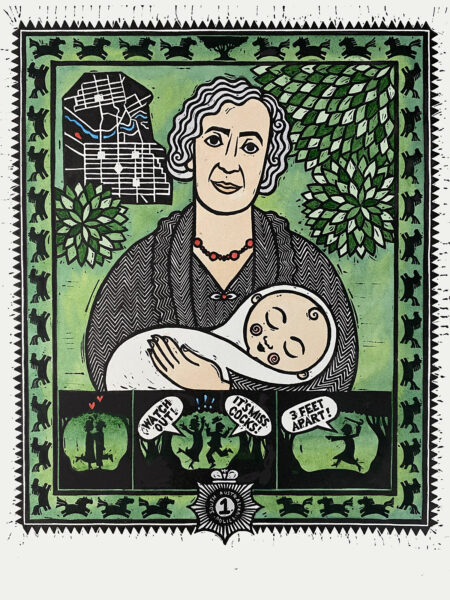
Kate Cocks
Kate Cocks was born Fanny Kate Boadicea Cock in Moonta on 5 May 1875. In 1915 she became the first female police constable not only in South Australia, not only in Australia, but in the British Empire. Probably even in the world.
In 1916 the Advertiser reported that, ‘During the last few years it has become the fashion among people to do their courting lying down. It is now the practice for them to lie down so closely together as to appear immodest but many of them are respectable.’ Kate Cocks was was not amused and became famous for her vigilance in the Parklands, using her cane and her catchphrase, ‘Three feet apart!’ to separate lovers.
The Kate Cocks Memorial Babies Home at Brighton was named in honour of her work with unmarried mothers and their babies.
Kate Cocks Park is a V-shaped portion of the Adelaide Parklands Park 27, Bonython Park or Tulya Wardli (Police home). Adjacent to the old Adelaide Gaol, scattered with ancient olive trees, this area is the home of the SA Police Mounted Operations Unit and their horses, the Police ‘greys’.
